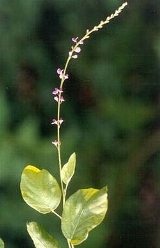
Desmodium
Encyclopedia
Desmodium is a genus
in the flowering plant
family
Fabaceae
, sometimes called tick-trefoil, tick clover or beggar lice. There are dozens of species
and the delimitation of the genus has shifted much over time.
These are mostly inconspicuous legumes; few have bright or large flowers. Though some can become sizeable plants, most are herb
s or small shrub
s. Their fruit are loment
s, meaning each seed
is dispersed individually enclosed in its segment. This makes them tenacious plants and some species are considered weed
s in places. They do have a variety of uses though, which are not readily apparent from their modest looks.
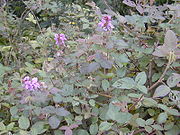
 Several Desmodium species contain potent secondary metabolites. They are used aggressively in agriculture as part of the push-pull technology
Several Desmodium species contain potent secondary metabolites. They are used aggressively in agriculture as part of the push-pull technology
. Tick-trefoils produce extremely high amounts of antixenotic allomone
s - chemicals which repel many insect
pests - and allelopathic compounds which kill weeds. For example, D. intortum and D. uncinatum are employed as groundcover in maize
and sorghum
fields to repel Chilo partellus stem-borer grass moths. They also suppress witchweeds such as Asiatic Witchweed (Striga asiatica) and Purple Witchweed (S. hermonthica
).
Tick-trefoils are generally useful as living mulch
and as green manure
, as they are able to replenish soil fertility due to their nitrogen fixation
. Most also give good animal fodder
.
Some Desmodium species were shown to contain elevated amounts of tryptamine
alkaloid
s. This is widespread in this genus and its relatives, and many tryptamine-containing plants treated in Desmodium are not placed herein anymore (see also below).
DMT
and 5-MeO-DMT
have been shown to occur in all green parts of D. gangeticum
, as well as the roots. D. triflorum
roots contain DMT-N-oxide.
There do not appear to be many animals that regularly feed on Desmodium, but detailed research in these interesting plants is lacking. Lesser Grass Blue (Zizina otis) caterpillar
s are known to feed in tick-trefoil, as well as, occasionally, those of the Two-barred Flasher (Astraptes fulgerator).
and systematics
of the many dozens of Desmodium species
are extremely confusing and far from resolved. Related genera such as Codariocalyx
, Hylodesmum, Lespedeza
, Ohwia and Phyllodium
were and sometimes still are included in Desmodium.
Many of these plants being rather small, inconspicuous and nondescript, the same taxa have been applied to what later turned out to be very different species. For example, D. spirale as described by August Grisebach
might refer to a distinct species but its validity is doubtful; the "D. spirale" of other authorities may refer to either of D. neomexicanum, D. ospriostreblum or D. procumbens. Similarly, the plant originally described as D. podocarpum by A. P. de Candolle
is Hylodesmum podocarpum today, but "D. podocarpum" might also mean D. hookerianum or Hylodesmum laxum, depending on the taxonomic authority.
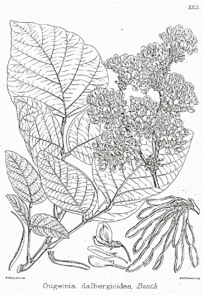
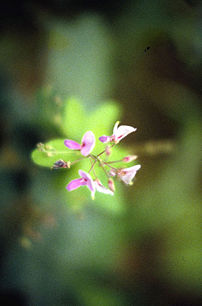
and many more
Genus
In biology, a genus is a low-level taxonomic rank used in the biological classification of living and fossil organisms, which is an example of definition by genus and differentia...
in the flowering plant
Flowering plant
The flowering plants , also known as Angiospermae or Magnoliophyta, are the most diverse group of land plants. Angiosperms are seed-producing plants like the gymnosperms and can be distinguished from the gymnosperms by a series of synapomorphies...
family
Family (biology)
In biological classification, family is* a taxonomic rank. Other well-known ranks are life, domain, kingdom, phylum, class, order, genus, and species, with family fitting between order and genus. As for the other well-known ranks, there is the option of an immediately lower rank, indicated by the...
Fabaceae
Fabaceae
The Fabaceae or Leguminosae, commonly known as the legume, pea, or bean family, is a large and economically important family of flowering plants. The group is the third largest land plant family, behind only the Orchidaceae and Asteraceae, with 730 genera and over 19,400 species...
, sometimes called tick-trefoil, tick clover or beggar lice. There are dozens of species
Species
In biology, a species is one of the basic units of biological classification and a taxonomic rank. A species is often defined as a group of organisms capable of interbreeding and producing fertile offspring. While in many cases this definition is adequate, more precise or differing measures are...
and the delimitation of the genus has shifted much over time.
These are mostly inconspicuous legumes; few have bright or large flowers. Though some can become sizeable plants, most are herb
Herb
Except in botanical usage, an herb is "any plant with leaves, seeds, or flowers used for flavoring, food, medicine, or perfume" or "a part of such a plant as used in cooking"...
s or small shrub
Shrub
A shrub or bush is distinguished from a tree by its multiple stems and shorter height, usually under 5–6 m tall. A large number of plants may become either shrubs or trees, depending on the growing conditions they experience...
s. Their fruit are loment
Loment
A loment is a type of modified legume that breaks apart at constrictions occurring between the segments of the seeds. Being a legume, it is dry at maturity and is dehiscent, meaning that it will split open at maturity....
s, meaning each seed
Seed
A seed is a small embryonic plant enclosed in a covering called the seed coat, usually with some stored food. It is the product of the ripened ovule of gymnosperm and angiosperm plants which occurs after fertilization and some growth within the mother plant...
is dispersed individually enclosed in its segment. This makes them tenacious plants and some species are considered weed
Weed
A weed in a general sense is a plant that is considered by the user of the term to be a nuisance, and normally applied to unwanted plants in human-controlled settings, especially farm fields and gardens, but also lawns, parks, woods, and other areas. More specifically, the term is often used to...
s in places. They do have a variety of uses though, which are not readily apparent from their modest looks.
Uses


Push-pull technology
The push–pull technology is a strategy for controlling agricultural pests by using repellent "push" plants and trap "pull" plants. For example, cereal crops like maize or sorghum are often infested by stem borers...
. Tick-trefoils produce extremely high amounts of antixenotic allomone
Allomone
An allomone is any chemical substance produced and released by an individual of one species that affects the behaviour of a member of another species to the benefit of the originator but not the receiver...
s - chemicals which repel many insect
Insect
Insects are a class of living creatures within the arthropods that have a chitinous exoskeleton, a three-part body , three pairs of jointed legs, compound eyes, and two antennae...
pests - and allelopathic compounds which kill weeds. For example, D. intortum and D. uncinatum are employed as groundcover in maize
Maize
Maize known in many English-speaking countries as corn or mielie/mealie, is a grain domesticated by indigenous peoples in Mesoamerica in prehistoric times. The leafy stalk produces ears which contain seeds called kernels. Though technically a grain, maize kernels are used in cooking as a vegetable...
and sorghum
Sorghum
Sorghum is a genus of numerous species of grasses, one of which is raised for grain and many of which are used as fodder plants either cultivated or as part of pasture. The plants are cultivated in warmer climates worldwide. Species are native to tropical and subtropical regions of all continents...
fields to repel Chilo partellus stem-borer grass moths. They also suppress witchweeds such as Asiatic Witchweed (Striga asiatica) and Purple Witchweed (S. hermonthica
Striga hermonthica
Striga hermonthica, commonly known as purple witchweed, is a parasitic plant belonging to the genus Striga. It is devastating to "major crops such as sorghum and rice . In subsaharan Africa in addition to S. bicolor, and O...
).
Tick-trefoils are generally useful as living mulch
Living mulch
In agriculture, a living mulch is a cover crop interplanted or undersown with a main crop, and intended to serve the functions of a mulch, such as weed suppression and regulation of soil temperature...
and as green manure
Green manure
In agriculture, a green manure is a type of cover crop grown primarily to add nutrients and organic matter to the soil. Typically, a green manure crop is grown for a specific period of time , and then plowed under and incorporated into the soil while green or shortly after flowering...
, as they are able to replenish soil fertility due to their nitrogen fixation
Nitrogen fixation
Nitrogen fixation is the natural process, either biological or abiotic, by which nitrogen in the atmosphere is converted into ammonia . This process is essential for life because fixed nitrogen is required to biosynthesize the basic building blocks of life, e.g., nucleotides for DNA and RNA and...
. Most also give good animal fodder
Fodder
Fodder or animal feed is any agricultural foodstuff used specifically to feed domesticated livestock such as cattle, goats, sheep, horses, chickens and pigs. Most animal feed is from plants but some is of animal origin...
.
Some Desmodium species were shown to contain elevated amounts of tryptamine
Tryptamine
Tryptamine is a monoamine alkaloid found in plants, fungi, and animals. It is based around the indole ring structure, and is chemically related to the amino acid tryptophan, from which its name is derived...
alkaloid
Alkaloid
Alkaloids are a group of naturally occurring chemical compounds that contain mostly basic nitrogen atoms. This group also includes some related compounds with neutral and even weakly acidic properties. Also some synthetic compounds of similar structure are attributed to alkaloids...
s. This is widespread in this genus and its relatives, and many tryptamine-containing plants treated in Desmodium are not placed herein anymore (see also below).
DMT
Dimethyltryptamine
N,N-Dimethyltryptamine is a naturally occurring psychedelic compound of the tryptamine family. DMT is found in several plants, and also in trace amounts in humans and other mammals, where it is originally derived from the essential amino acid tryptophan, and ultimately produced by the enzyme INMT...
and 5-MeO-DMT
5-MeO-DMT
5-MeO-DMT is a powerful psychedelic tryptamine. It is found in a wide variety of plant and psychoactive toad species and, like its close relatives DMT and bufotenin , it has been used as an entheogen by South American shamans for thousands of years.-Chemistry:5-MeO-DMT was first synthesized in...
have been shown to occur in all green parts of D. gangeticum
Desmodium gangeticum
Desmodium gangeticum is plant in the Fabaceae family....
, as well as the roots. D. triflorum
Desmodium triflorum
Desmodium triflorum is an ornamental plant in the Fabaceae family....
roots contain DMT-N-oxide.
There do not appear to be many animals that regularly feed on Desmodium, but detailed research in these interesting plants is lacking. Lesser Grass Blue (Zizina otis) caterpillar
Caterpillar
Caterpillars are the larval form of members of the order Lepidoptera . They are mostly herbivorous in food habit, although some species are insectivorous. Caterpillars are voracious feeders and many of them are considered to be pests in agriculture...
s are known to feed in tick-trefoil, as well as, occasionally, those of the Two-barred Flasher (Astraptes fulgerator).
Taxonomy and systematics
The taxonomyTaxonomy
Taxonomy is the science of identifying and naming species, and arranging them into a classification. The field of taxonomy, sometimes referred to as "biological taxonomy", revolves around the description and use of taxonomic units, known as taxa...
and systematics
Systematics
Biological systematics is the study of the diversification of terrestrial life, both past and present, and the relationships among living things through time. Relationships are visualized as evolutionary trees...
of the many dozens of Desmodium species
Species
In biology, a species is one of the basic units of biological classification and a taxonomic rank. A species is often defined as a group of organisms capable of interbreeding and producing fertile offspring. While in many cases this definition is adequate, more precise or differing measures are...
are extremely confusing and far from resolved. Related genera such as Codariocalyx
Codariocalyx
Codariocalyx is a genus of flowering plants in the legume family, Fabaceae. It belongs to the sub family Faboideae....
, Hylodesmum, Lespedeza
Lespedeza
Lespedeza is a genus of some 40 species of flowering plants in the pea family , commonly known as bush clovers or Japanese clovers...
, Ohwia and Phyllodium
Phyllodium
Phyllodium is a genus of flowering plants in the legume family, Fabaceae. It belongs to the sub family Faboideae....
were and sometimes still are included in Desmodium.
Many of these plants being rather small, inconspicuous and nondescript, the same taxa have been applied to what later turned out to be very different species. For example, D. spirale as described by August Grisebach
August Grisebach
August Heinrich Rudolf Grisebach was a German botanist and phytogeographer. Born in Hannover on April 17, 1814, he died at Göttingen on May 9, 1879.- Biography :...
might refer to a distinct species but its validity is doubtful; the "D. spirale" of other authorities may refer to either of D. neomexicanum, D. ospriostreblum or D. procumbens. Similarly, the plant originally described as D. podocarpum by A. P. de Candolle
A. P. de Candolle
Augustin Pyramus de Candolle also spelled Augustin Pyrame de Candolle was a Swiss botanist. René Louiche Desfontaines launched Candolle's botanical career by recommending him at an herbarium...
is Hylodesmum podocarpum today, but "D. podocarpum" might also mean D. hookerianum or Hylodesmum laxum, depending on the taxonomic authority.
Selected species


- Desmodium acanthocladum F.Muell.
- Desmodium adscendens DC.
- Desmodium canadenseDesmodium canadenseDesmodium canadense is a native North American forb of the Fabaceae family.- External links :* *...
– Showy Tick-trefoil, Canadian Tick-trefoil - Desmodium canescens – Hoary Tick-trefoil
- Desmodium ciliare (Muhl.) DC. – Hairy Small-leaved Tick-trefoil
- Desmodium concinnum DC.
- Desmodium concinnum var. concinnum (= D. penduliflorum Benth.)
- Desmodium cuspidatum (Muhl.) Loudon – Toothed Tick-trefoil, Large-bracted Tick-trefoil
- Desmodium dillenii Darl. (sometimes considered a variety of D. paniculatum)
- Desmodium discolor Vog.
- Desmodium elegans DC.
- Desmodium gangeticumDesmodium gangeticumDesmodium gangeticum is plant in the Fabaceae family....
- Desmodium glabrum (Mill.) DC. (= D. molle (Vahl) DC.)
- Desmodium glutinosum (Willd.) Alph. Wood – Pointed-leaved Tick-trefoil, Large Tick-trefoil
- Desmodium hookerianum D. Dietr. (= D. podocarpum Hook. & Arn.)
- Desmodium illinoense – Illinois Tick-trefoil
- Desmodium incanumDesmodium incanumDesmodium incanum, known as creeping beggarweed or Spanish clover/tick-trefoil, is a perennial plant native to Central and South America...
– Creeping Beggarweed, Spanish Clover, Spanish Tick-trefoil, Kaimi Clover or kaʻimi (Hawaiʻi) - Desmodium intortum
- Desmodium khasianum (= D. oxyphyllum auct. non DC.)
- Desmodium laxiflorum DC. (= D. incanum sensu auct.)
- Desmodium lineatum (Michx.) DC. – Linear-leaved Tick-trefoil
- Desmodium marilandicum (L.) DC. – Smooth Small-leaved Tick-trefoil
- Desmodium nemorosum F.Muell. ex Benth.George BenthamGeorge Bentham CMG FRS was an English botanist, characterized by Duane Isely as "the premier systematic botanist of the nineteenth century".- Formative years :...
- Desmodium neomexicanum (= D. bigelovii, D. humile, D. lilloanum, D. parvum, D. spirale auct. non DC. non Griseb. non (Sw.) DC., D. spirale (Sw.) DC. var. bigelovii)
- Desmodium nudiflorum (L.) DC. – Bare-stemmed Tick-trefoil, Naked-flowered Tick-trefoil
- Desmodium oojeinense
- Desmodium ospriostreblum (= D. spirale DC., D. tortuosum sensu Hepper)
- Desmodium paniculatumDesmodium paniculatumDesmodium paniculatum, or Panicled Tick-Trefoil, is a flowering plant located in the United States....
(L.) DC. – Panicled Tick-trefoil - Desmodium perplexum – Perplexed Tick-trefoil
- Desmodium procumbens (= D. spirale (Sw.) DC., D. sylvaticum, D. tenuiculum)
- Desmodium psilocarpum
- Desmodium rhytidophyllum F.Muell. ex Benth.George BenthamGeorge Bentham CMG FRS was an English botanist, characterized by Duane Isely as "the premier systematic botanist of the nineteenth century".- Formative years :...
- Desmodium rigidum (Ell.) DC. – Rigid Tick-trefoil
- Desmodium rotundifolium (Michx.) DC. – Prostrate Tick-trefoil, Round-leaved Tick-trefoil, Dollar Leaf
- Desmodium spirale Griseb. (disputed)
- Desmodium tortuosum (Sw.) DC.
- Desmodium triflorumDesmodium triflorumDesmodium triflorum is an ornamental plant in the Fabaceae family....
- Desmodium uncinatum – Silver-leaved Tick-trefoil, "silverleafSilverleafSilver leaf or Silverleaf may refer to:* Silver leaf , a fungal disease of trees.* Silverleaf , an evergreen shrub* Silverleaf oak is the common name for Quercus hypoleucoides* A fictional herb in the game Warcraft...
" - Desmodium varians (Labill.) G.Don
Formerly placed here
- Codariocalyx motoriusCodariocalyx motoriusCodariocalyx motorius , known as the Telegraph Plant or Semaphore Plant, is a tropical Asian shrub, one of a few plants capable of rapid movement; others include Mimosa pudica and the Venus Flytrap....
– Telegraph Plant (as D. gyrans, D. motorium, D. roylei) - Hylodesmum laxum (as D. laxum DC.)
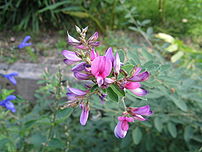
- Hylodesmum laxum ssp. laxum (as D. austro-japonense, D. bambusetorum, D. gardneri auct. non Benth., D. laxiflorum sensu Miq., D. laxum var. kiusianum, D. laxum ssp. laxum, D. podocarpum auct. non DC. non Hook. & Arn., D. podocarpum DC. var. gardneri sensu Bedd., D. podocarpum DC. var. laxum)
- Hylodesmum leptopus (as D. gardneri Benth., D. laxum auct. non DC., D. laxum ssp. leptopus, D. leptopus, D. tashiroi)
- Hylodesmum podocarpum (as D. podocarpum DC., D. podocarpum DC. var. indicum, D. podocarpum DC. var. japonicum)
- Hylodesmum podocarpum ssp. oxyphyllum (as D. fallax var. mandshuricum, D. japonicum, D. mandshuricum, D. oxyphyllum DC., D. podocarpum DC. var. mandshuricum, D. podocarpum DC. ssp./var. oxyphyllum, D. podocarpum DC. var. polyphyllum, D. podocarpum DC. var. typicum, D. racemosum)
- Lespedeza thunbergii (as D. formosum, D. thunbergii)
- Lespedeza thunbergii var. thunbergii (as D. penduliflorum Oudem.)
- Ohwia caudata (as D. caudatum)
- Phyllodium pulchellumPhyllodium pulchellumPhyllodium pulchellum is a plant in the Fabaceae family....
(as D. pulchellum)
and many more
External links
- Trout’s Notes on the Genus Desmodium Chemistry, ethnomedicine, pharmacology, synonyms and miscellany (pdf)

